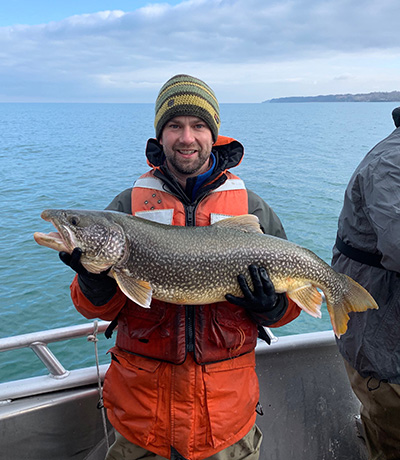 If someone told you they caught five fish weighing in at over 82 pounds in one outing on Lake Erie, would you believe them? Well, such was the case for DEP Great Lakes Biologist James Grazio and his team one afternoon this past fall when they boated five lake trout, the biggest being 20 pounds and 37 inches long. But this wasn’t your normal group of anglers, and they didn’t “catch” them with your typical fishing tackle. Instead, they utilized gill nets while conducting a fish tissue sampling excursion. In cooperation with the Pennsylvania Fish and Boat Commission, the Pennsylvania Department of Health, and the Pennsylvania Department of Agriculture, DEP conducts samplings such as this throughout the year as part of a routine monitoring program.
If someone told you they caught five fish weighing in at over 82 pounds in one outing on Lake Erie, would you believe them? Well, such was the case for DEP Great Lakes Biologist James Grazio and his team one afternoon this past fall when they boated five lake trout, the biggest being 20 pounds and 37 inches long. But this wasn’t your normal group of anglers, and they didn’t “catch” them with your typical fishing tackle. Instead, they utilized gill nets while conducting a fish tissue sampling excursion. In cooperation with the Pennsylvania Fish and Boat Commission, the Pennsylvania Department of Health, and the Pennsylvania Department of Agriculture, DEP conducts samplings such as this throughout the year as part of a routine monitoring program.
 “Generally, when we conduct samplings, we are able to utilize standard methods such as electrofishing or hook and line fishing to accomplish the task,” said Grazio. “However, sampling fish on Lake Erie often requires specialized techniques such as gill nets.”
“Generally, when we conduct samplings, we are able to utilize standard methods such as electrofishing or hook and line fishing to accomplish the task,” said Grazio. “However, sampling fish on Lake Erie often requires specialized techniques such as gill nets.”
Because lake trout prefer the deepest, coldest waters of Lake Erie, fall is the best time to target this species. Lake trout move toward shallower water, congregating over rocky reefs in the lake during this spawning period. It is in these areas where DEP Great Lakes biologists deploy the gill nets, which were widely used in the past by commercial fisherman but have since been limited to use by scientific collectors through a special permit due to their effectiveness. Gill nets are long, monofilament mesh nets that are suspended in the water column and anchored to a staff buoy. Generally, these nets are deployed for 24 hours, allowing enough time for passing fish to entangle themselves within the nets.
 Once collected, DEP Great Lakes biologists take the lake trout back to the lab and conduct the fish tissue sampling. These samples are tested for the presence of heavy metals, pesticides, and polychlorinated biphenyls (PCBs — chemicals that were once widely used in the electrical industry but are no longer produced.)
Once collected, DEP Great Lakes biologists take the lake trout back to the lab and conduct the fish tissue sampling. These samples are tested for the presence of heavy metals, pesticides, and polychlorinated biphenyls (PCBs — chemicals that were once widely used in the electrical industry but are no longer produced.)
“Legacy environmental contaminants like polychlorinated biphenyl (PCBs), dioxins, and organochlorine pesticides, while no longer produced, still persist in ever-diminishing quantities in Lake Erie today,” said Grazio. “Mercury, other metals, plastics, and a wide array of modern chemicals continue to enter the lake ecosystem. Some of these pollutants find their way into the food chain, posing an ongoing risk to the health of Lake Erie’s fishes as well as to the people that eat them.”

Some environmental contaminants like mercury and PCBs build up in the flesh of Lake Erie’s fishes. Not only do they tend to accumulate in individual fishes, they are magnified up the food chain as bigger fish eat smaller fish that already have contaminants in their body tissues. The longer a fish lives, the fattier it is; and the higher that it sits in the food chain, the more likely it is to accumulate harmful levels of contaminants in its flesh. In Lake Erie, the native lake trout is a top predator that demonstrates this effect as they can live up to 40 years.
 Currently, lake trout over 30 inches and carp over 20 inches are the only two species in Lake Erie carrying a “Do Not Eat” designation. However, out of an abundance of caution, there is a general statewide advisory of “one meal per week” for all recreationally caught sport fishes in PA.
Currently, lake trout over 30 inches and carp over 20 inches are the only two species in Lake Erie carrying a “Do Not Eat” designation. However, out of an abundance of caution, there is a general statewide advisory of “one meal per week” for all recreationally caught sport fishes in PA.
“This fish consumption advisory program allows Pennsylvania residents to make informed decisions about eating the fish they catch,” said Grazio. “By consulting our published advisories, residents can maximize the many health benefits of eating fish while minimizing the risk associated with some species and waterbodies.”
Results from DEP’s fish tissue advisory program are posted on
DEP’s fish consumption web page as well as in the Pennsylvania Fishing Summary Booklet provided with the purchase of a fishing license.